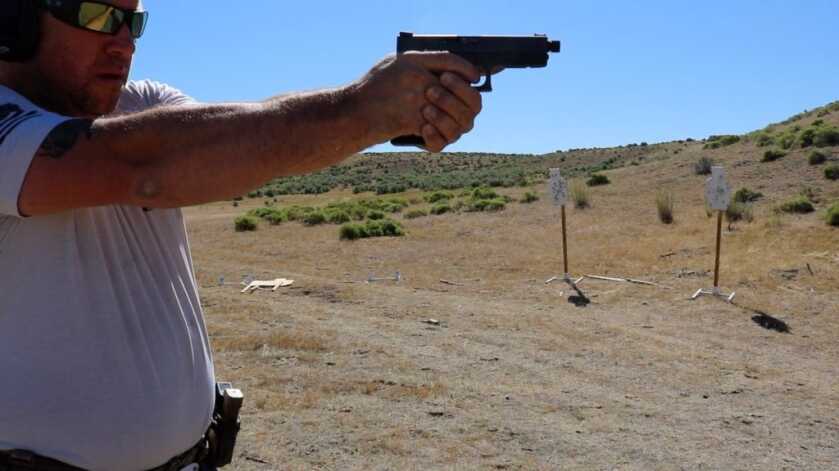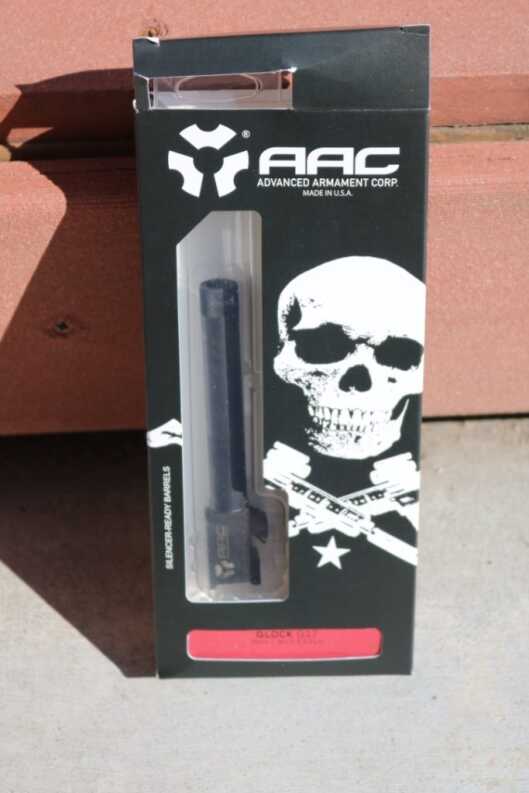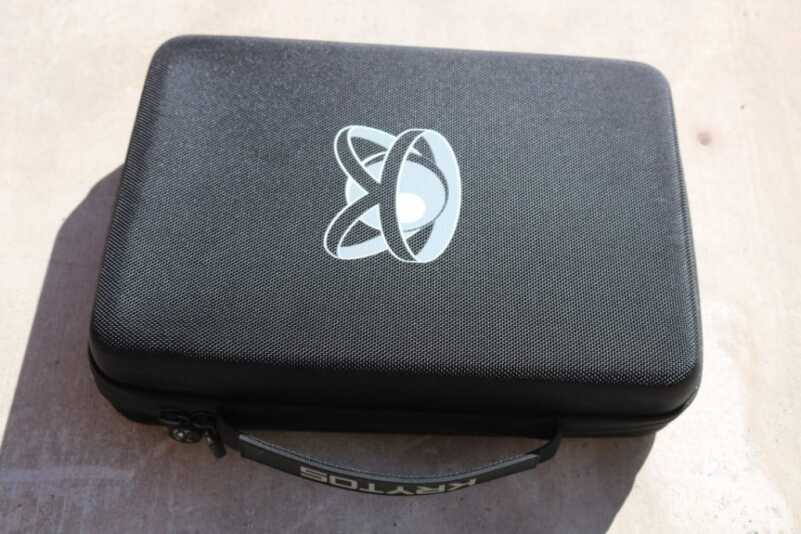
If a Glock were a car component, it would be a small block Chevrolet. A Glock can do almost anything, and the aftermarket abounds with options. You can actually build a Glock clone that doesn’t have one factory Glock part in it, without much effort. You can spend a fortune in the quest for performance, or just for looks. But what else is true of the firearms industry? Well, unfortunately, 80% of the new add-ons we see every year are gimmicks. They either do nothing or actually degrade performance, and that is just how the game is played. But this week we are looking at something that is actually revolutionary, at least for a certain market segment.
When I first heard of the Krytos titanium slide project, I was less than excited. Like many of you, I have enough experience with titanium to be wary. And while I am not a materials engineer, I did at least go to college for it. Then I decided to enlist in the USMC instead of finishing because I make good life choices. But a basic understanding of metallurgy, compounded with years in the firearms world, gave me some valid reasons to distrust Ti in guns.
What do we know about titanium in weapons? It is strong, true. It is lightweight for strength, and incredibly corrosion resistant. But it has also had issues with cracking. We all remember the attempts at titanium frame semi autos, and how hard they are to find now. Depending on the alloy, titanium can become very brittle. Titanium traditionally has performed worse than steel in erosion resistance. If you value durability overweight, you buy the steel baffle stack for your suppressor. Titanium also has a bad habit of galling, which is wear caused by adhesion between moving surfaces.
Titanium is also weird when it comes to coatings. Titanium moves, it is less rigid than steel. In fact, with your thumb, you could eventually rub a hole in raw titanium. What this means for coatings like PVD, is that under stress they flake off like paint chips.
What this has traditionally meant is that Titanium is great for things like knives, if you care more about corrosion and magnetic properties than you do hard use durability. On guns, not so much.
Recently, that has changed. Krytos isn’t just a couple nerds with a CNC machine tossing slides out the door that will shatter in 5000 rounds. In fact, this development didn’t even come from the firearms industry to start with. Which is all the more reason to trust that it is real.
I’m in the gun industry, and you care about it or else you wouldn’t be reading this. So it might sound strange that I am being so rough on the goose that pays my mortgage. But to understand my skepticism of anything gun, you just have to look at a baseline economic reality. Small arms worldwide, including nation states, is about $11 billion dollars a year. Granted, that makes my financial problems seem small. As in, it would cover a couple sets of tires on the Raptor with a case or two of 9mm left over. But compared to other real-world industries, it is chump change. Also, worth $11 Billion dollars annually are Dewalt brand tools and NASCAR. Each. Not auto racing worldwide, just NASCAR. And for further comparison, $11 Billion dollars would buy you 5 Ohio Class submarines, or 12 Stealth bombers. When it comes to money spent, firearms just aren’t that big of a deal. Which further allows us to deduce ala Sherlock Holmes where the best engineers and R&D budgets are at. If you are top of your class at MIT, do you think it is better to accept the offer from Lockheed Martin or Remington? Me too.
Krytos has a titanium finishing process that wasn’t developed for firearms. It was developed for the aerospace industry, with the backing of a huge research budget. One of “said” developers was just gun dork enough to realize the potential, and what it could mean for guns. So the technology is patented, with dual-use authorized. And God help whoever infringes on that because they won’t be facing the legal wrath of a garage operation. With the mickey mouse patent fights we see in the firearms world, I almost giggle to think about somebody calling down the fire with this one.

The process is called ArmorTi, and the most important part about it is that it isn’t a coating. It is a forced diffusion, that actually bonds with the metal near the surface of the Titanium. This leaves a super hard, erosion resistant, durable outer shell, that retains all the properties of titanium that we like. It also has a surface lubricity that eliminates friction related problems. Time will tell, but the science looks to have solved the problems.
During internal testing, Krytos has run multiple slides past the 100,000 cycle test without issues. While not common, that is about the point you see steel slides start to crack. By that, I meant that it doesn’t happen often, but it does happen. In testing, they plugged the barrel, fired a round, and the slide survived to continue shooting. Obviously with a new barrel, because the old one did the banana peel. But the survival of the slide is a huge deal. All in all, they beat the living hell out of this product before it came to market, and then they passed the first batch off to savages to continue testing.
So now that titanium is an option, why would you want one? If you have ever carried a duty sized gun for a living, the answer is obvious. The titanium slide on a G17 instantly shaves 6 ounces off the weight of the gun, which is huge. When you are working in the mountains at high altitude, every ounce starts to count. Troops have been known to drill holes in belt buckles to drop weight. 6 ounces off a gun, yes please. The same thing applies to Law Enforcement. Just the weight on you hip day in and day out is wearing. Shaving 25% off is a huge relief. Factor all that in with the corrosion resistance, and we have a winner.
Are their drawbacks? Maybe. Depends on how you feel about recoil. Having now shot the Krytos slide, I still can’t tell you for certain if it has more recoil than a steel slide. The slide weight is roughly half, and the speed increased by about 50%. I lack enough physics classes to tell you for certain that recoil is properly calculated as momentum, not kinetic energy. It seems logical to me, but Bill Nye might disagree. The formula for momentum is speed times mass, which in this equation means it is lower on the lighter slide. Kinetic energy is ½ mass times speed squared, which gives a different answer. And neither of those is a 100% real world answer. A lot of what we perceive as recoil is a feel rather than a mathematical certainty. After shooting, I would just say this. The recoil is different. It is sharper, but it is also over faster. I would equate it to the same feeling as scaled down 40 cal, if that makes any sense. And we haven’t even started playing with recoil spring weight, which may yield further developments.
In the box, the slide comes stripped. The idea here is that since you already own a Glock, you can strip your parts out and slap them in the new slide. Krytos went to great lengths to replicate every dimension of a factory Glock slide, to include the look. The only real change is addition of front cocking serrations. Since I wanted to compare the Ti slide to my steel one, I built the slide up complete. I already had a Glock rebuild kit laying around, as any good Production shooter would do. For a barrel, I opted for an AAC threaded barrel. AAC has traditionally made good parts, so no reason a G-17 barrel should be any different. It also gives me the option to suppressor test this set up later.

For sights, I went with the tried and true Dawson Precision. No one in the game knows more about sights than Dawson, and I would bet no sights have more Championships. I have used Dawson for years, they are fantastic.

This time, I went with the fiber optic front and Charger rears. The Chargers feature a small shelf built into the sight for one-handed manipulation. I also like that the fronts and rears are available in a variety of widths. Go with the wide rear notch for lightning fast acquisition. At a price of $78.95 a set, you really can’t go wrong.



With initial testing done on the slide, I know this – I want one. For my 17, I can’t imagine not having one. And I can’t wait for the Gen 5 slide, to slap on my 19X. Which means that for once this paragraph is my favorite to write. The regular slide retails for $549, the red dot cut is $599. I actually called the company to make sure that was right because it sounds too good to be true. When you consider that most places start at $800 to cut on YOUR steel slide, this is a bargain. And if you’ve ever carried a gun above 8000 feet, it’s a must-have.
P.S – almost as an afterthought, I tested the Krytos slide with extended magazines. The magazine is part of the ejection cycle on a Glock, so it is imperative that it is tested. GunMagWarehouse provided one of the new ETS red 31 rounders, and it passed with flying colors.

Kyrtos has a great website with a FAQ section that will educate you on titanium and their proprietary coating that you can check out here.






Glock isn’t a gun. Like iphones and Harley Davidson it is a religion. If the Springfield XD and the Smith and Wesson M and P series had come out before Glock, there wouldn’t be a Glock today. They are both better guns.
The problem with that comment is that it ignores the evolutionary line. When I first read about this new Austrian “plastic service pistol” it was in SOF in 1985. There was nothing else even remotely like it in the world. The Safe Action trigger/striker with no safety, the technological leap of embedding the steel rails into the polymer lower, the industry leading Tennifer coating… PLUS…. in a world where we all just expected an auto to jam every now and then… the Glock 17 just didn’t. It ran and ran and ran in utter defiance of all our expectations of a “disposable plastic pistol.”
I agree there are great designs out there now that compete with the basic Glock design. But at least give Gaston credit for being the base design on which they are built. The Springfiled XD or the S&W XXX… it wasn’t possible for them to “come out first” since they started with the Glcok design.
Just like there would have never been an Android phone OS unless they had the Apple iPhone to copy…. even Jobs was shocked that they just outright stole the basic operating design!
Except HK pioneered both polymeruse in a pistol with the VP70 and strikers with the P7. Glock makes a functional pistol, yes, but the only reason they are ubiquitous is their marketing campaign and the millions of pistols they have basically given to law enforcement agencies. Absolutely nothing special about them. Why do you think everyone has to spend as much on the pistol on custom parts to make them worth a damn?
I beg to differ. I own one of the first 17’s to come to America. I have done nothing to it and put thousands of rounds through it with no problems. I loaned the gun to my son when he went through the Police academy and he beat everyone in competition shooting. I own many hand guns and used to be a FFL dealer. Glock is a great gun and my personal experience with them is that they will do what you want right out of the box and there is no need for you to customize it other than the fact you want to.
Then a 1945 Remington Rand 1911A1 and a Harley Trike for me please sir…
Would a super soaker of lemonade and David hoggs urban survival tricycle do?
😀
I worked and retired from Lockheed Martin. Given a do-over, I would choose Remington.